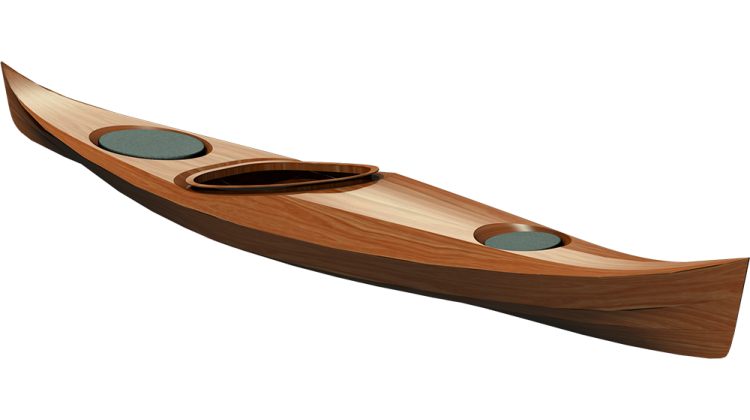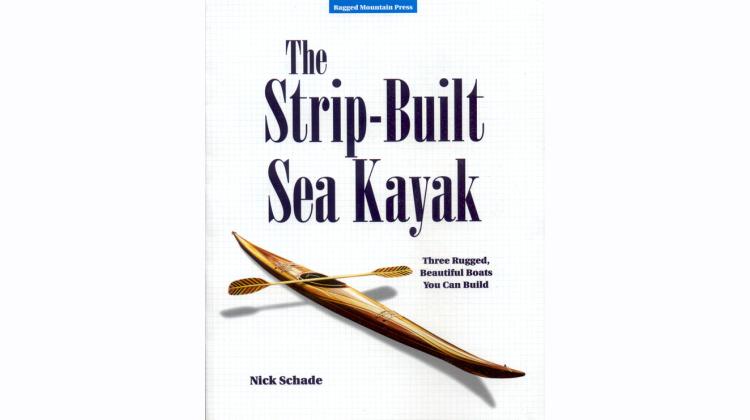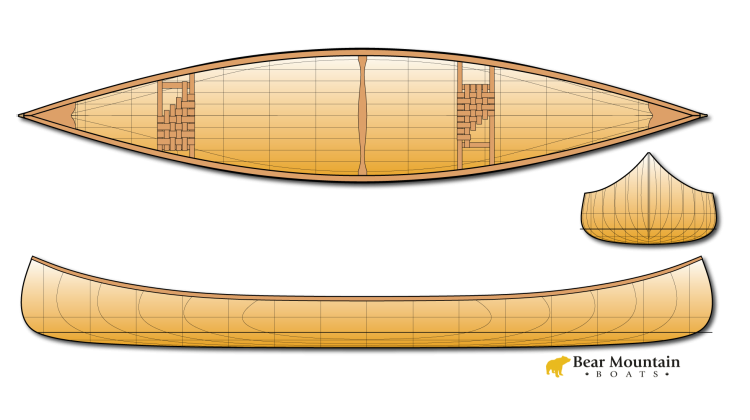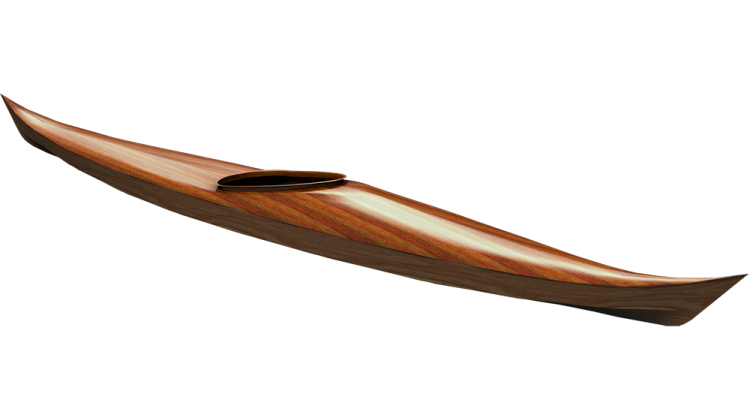Nick and his friend Bill are continuing their work on building a Petrel Play sea kayak kit from Chesapeake Light Craft. In this episode, they are focused on running fiberglass tape down the inside seam of the kayak. Nick starts by sealing the seam with green tape to prevent epoxy from draining out. He then prepares the fiberglass tape by cutting it to size and laying it out on a wax paper-covered workbench. Nick heavily saturates the tape with epoxy before carefully applying it to the inside seam, using a brush on a stick to reach the tight spaces.
Bill takes over applying the tape to the stern seam, and the two work together to ensure the tape is properly centered and wrinkle-free. They encounter a few challenges, such as the tape wanting to roll off the seam and the difficulty of reaching the full length of the seam. Nick and Bill use various techniques, including re-rolling the tape and using their fingers to push it into the seam, to overcome these issues.
After completing the tape application, Nick and Bill discuss the difficulty of this task and the various methods people have tried, such as using hot-melt glue. They acknowledge that while it's not the most enjoyable part of the build, it's a necessary step and doesn't take too long.
Chapters
- 0:00 Introduction to the workshop
- 0:25 Preparing to run fiberglass tape
- 0:50 Sealing the seam with tape
- 1:58 Preparing the fiberglass tape
- 2:43 Laying out the fiberglass tape
- 6:22 Applying epoxy to the fiberglass tape
- 10:50 Unrolling and applying the fiberglass tape
- 16:07 Completing the fiberglass tape application
- 22:53 Wrapping up and looking ahead
Hey, welcome back to The Guillemot Kayaks Workshop. Bill and I are continuing work on the Petrel Play SG, a stitch and glue sea kayak kit from Chesapeake Light Craft. It's my design, and Chesapeake Light Craft supplied us with the kit. You're joining us right after lunch. In the previous episode, we taped the whole hull and deck together with strapping tape. Now, we are running fiberglass tape down the inside seam. Let's get right to it.
Okay, so we're back from lunch. The deck and hull are taped in place, and we are gearing up to run seam tape down the inside seam. The first thing I want to do is take some green tape and seal up this seam here so epoxy doesn't drain out and end up with a starved seam. I want to take this tape, lay it right along that seam, and play it on one side, then take and fold it over again. We want to have a minimum of wrinkles in this because the wrinkles will fill up with epoxy.
Bill and I have to deal with excess epoxy, so by putting it on the lower side and then folding it over and burnishing it down, it ends up with a nice, smooth run. You're joining us right after lunch, and now we will put the boat up on edge. We want the seam right down at the bottom, so we don't want the boat tilted one way or the other. We'd like it right up on edge, and then we'll take a clamp.
The kit you bought came with this roll of 3-inch wide seam tape. This is a 9-ounce fiberglass, and it has a woven edge on it. This "salvaged edge" is a technical term, and it basically means the yarns turn around and head back the other way on that edge. This can be a problem when you've got this tape all the way up in the end here, and you have a sloppy wet brush and you're trying to draw that brush back down out of the boat without pulling the tape after you. We want to do something to keep this from happening because it gets really annoying.
If I take and cut the end of the cloth at an angle, that kind of solves the problem. Basically, this might unravel a little bit, but it's not going to be continuous until it gets all the way down here, so it's unlikely to be a problem. The process of this is we measure out the tape on the outside of the boat, just so we can roll it out and get a feel for the length. We have a piece for the stern and a piece for the bow, and they will overlap behind the cheek bite right here.
When I have the lengths measured out, I will then lay that out flat on my workbench over here on a piece of wax paper and then pre-saturate the tape with epoxy. I'll brush some epoxy down the inside seam and then roll the tape down the inside seam. We're going to use a brush on a stick, and the Petrel Play is short enough that we can use this short one. I can get all the way to the end technically, and I can get within 8 inches of the bow just reaching in with my hand, but I can't see what I'm doing there. With this brush on a stick, I'll be able to see what I'm doing inside there and come into the cockpit hatch and see what I'm doing. That's the benefit of the brush on the stick as opposed to just using your hands.
The saturated cloth gets laid down on that seam. We'll do one end, and then the other end. I'll do one seam, or let Bill do the other seam, and we'll see how it goes. Then, at that point, the next step is doing the seam on the other side. If we went right away and flipped the boat over, you'd end up with a piece of fiberglass tape falling on your head, so I'm going to just take this old brush off. These sticks have been used multiple times, but the brushes have only been used once. Sometimes it pays to drill a hole through your brush first, sometimes the brushes will split, but I'm going to live dangerously and just let's get it started through there and now put it on the end of my stick. Voila, brush on a stick. I cut the handle off here because we need to get pretty far into the ends, and that handle on the end gets in the way.
I'm going to lay out some wax paper here. I did a beautiful job cleaning up the shop, so I have a 6-foot length here with a clean area to lay stuff out. The cloth will be laid out on there, and I want to have the overlap of the tape be behind the cheek plate here. I'm going to roll it out here just along the seam and bring it most of the way to the end, remembering we've got an end pour up there, so we can't go all the way to the end. It gets really tight up in there where the brush won't fit, so we'll stop a hand length or so from the end of the boat. Again, we want to cut that off at a diagonal, so it won't fray as much.
Now I'll take this piece, lay it down over here, and the overlap will be about the width of the cheek plate. Okay, so it's a full overlap behind the cheek plate. All right, so it's just laid out there. Now I'm going to mix up some epoxy, a standard mix, and I'm going to take and brush it on the tape here fairly heavily. All that stuff I've talked about in the past where you don't want to overdo the epoxy, here we're going to overdo it a little bit. I want to make sure that this completely saturates this pretty heavy cloth.
Now I want to go down the inside seam. I've got a flashlight here to provide me a little bit of light in there, and I've got my brush on a stick and my regular brush here. I'm going to start from the cheek plate moving forward, just using the brush that I have here. There's a bit of an open gap here, and that's why I'm oversaturating the tape and brushing a fair amount in there. I want epoxy to run down into that gap, kind of like we're making a fillet in there, but we're not using thickened epoxy, we're just using regular thin epoxy. I'm going to go down and continue all the way down that seam. It's a little tricky here, you want to make sure you're putting it on the correct seam. It's the one here you can't really see very well, and then I'm going to go forward here along that seam as far as I can reach.
How critical is it that you get it the entire width of the tape? That's less critical since we've ultra-saturated the tape. It should be fine. I'm going to mix up just a little bit more epoxy here. The process can be a bit tricky to do in warm temperatures because the epoxy kicks off quicker. I've got the heat up a little bit here, but it's actually nice to have it a little bit cool so you've got more time to work. I want to get epoxy all the way to where the end pour is, even if we don't get the tape all the way up there. I'm going to put my stick in from the cockpit here, bring it up to the hatch, and then dip the brush in my bucket of epoxy, flip it over, and then run that all the way up into the end there, get it right to the tip.
It looks like I got all the way up there. You can't really see all the way to the end up there, but it goes around the corner. So now I've brushed that down, and I've still got some epoxy here. Now I'm going to take this roll of tape here, or this piece of tape, and start rolling it up. I'm going to get as tight a roll as I can manage because if you do a loose roll, it gets the whole roll to be a little bit tall. But you see that's well saturated.
On all my other boat builds, I've done something like this on the taping the inside seam, and you might find I do it different every time, but there's various ways to do this. But now we've got a nice, gooey roll of fiberglass there, saturated. There are a few dry spots in this, but we'll be able to see them when we roll it down on the boat. Going to take the end of the tape here, sneak it in behind the cheek plate, and down onto that seam. Get it pressed down a little bit there, and we want it centered on that seam. Now I'm going to roll it down that seam, trying to keep it centered. I'll reach over the roll and put my finger down into the seam so I can feel that, and now I'm going to reach down in and again, we may be able to get most of the way to the end of the tape reaching in through the hatch here.
I think I got it all, all the way unrolled. It's kind of beyond where I can see there. Oh, it came up off the seam, so I'm just going to take my brush and push it down that seam and hopefully catch the tail end of the cloth and straighten it out onto the seam a little bit. This process is the same way any composite kayak is put together, so any fiberglass, commercially made boat is assembled the same way.
Can't see in that way, did you catch all that, Bill? I got it. Whatever you do, don't get epoxy on my flashlight. No, no, that's a family heirloom. Okay, so now I've got a little bit more epoxy left in my bucket here. I'm just going to brush down this tape, and it might have some wrinkles as you brush on it, and we want to push it down into the corner of the seam there. The wrinkles will brush out towards the ends. I'm going to go all the way up into the end. I'm going to take one last brushful and go all the way up into the very tip of the boat. Let's see if we can do one like long glide from here all the way up to smooth out any wrinkles. All right, what do you think, Bill? Looks great, yeah, nice and smooth.
Yeah, it looks pretty good. I often end up with a few bubbles sort of in that groove between the deck and the hull, not ideal, but acceptable. And just brushing this down to smooth out some of the wrinkles, and again, if I just take my finger and drag it down into the groove of the seam, that'll push that cloth down into that groove, but that will have created a bit of a fillet in there. Some people have been known to go in with filling mix and smear filling mix there, and going through that process, not necessarily a bad idea, but I think it's an unnecessary step.
Okay, so that's the bow seam. We'll let Bill have the joy of the stern seam. Okay, so we got these lines here, so you want to overlap that a bit. Okay, yeah, so that's one of the tricky things here, is it wants to roll off of there, so you can't really pull on it. That's in a good spot, put it at a diagonal. All right, now we take this. Oh, yeah, epoxy, that's fine, the wet epoxy will just help saturate that a little bit quicker.
All right, and then take and brush some down the inside seam. Kind of flows right in there, yeah. And some of this you have to just do by feel pretty much. Yep, I was doing the wrong seam. Oops. Yep, that's that, I did warn you. You did. So I guess the idea here is just to brush a little more than you normally would, to make sure you get all the... And see how far you can reach in there. I apologize for the clamp in your way.
Interesting, and if you don't feel you're getting all the way to the end, you can use the brush on the stick, yeah, on need to. Right, it's all down in the crease there. I'm not sure that's the right term, probably not. It works, stuck to my hand. All right, interesting. Make sure I get some on your camera. Yeah, you can really feel it pretty good, actually. Yeah, it's not that hard. Should it go up there twice? That's probably enough. Okay, and then I'll just do a nice long one all the way back. I think it looks all right. Good.
All right, so now you can roll up the saturated tape and roll this up. So far, so good. Yeah, it can be tricky to keep straight. If it gets too stretched out, then it's hard to roll on the seam, and it's a little floppity, but I think it's all right. Try and tuck that, slide that, and see how one end. Oh, yeah, yeah, yeah, there you go. Oh, yeah, let's see that. So when it's in this state where it's rolled up in a wad like that, if it's really warm, it can kick off quickly. Okay, so you want to go from this to rolled out back in the boat quickly, fairly quickly, because it'll start to gum up and get sticky.
Mine's not quite as elegant as yours was, but that's all right. But I don't think I can fix that without undoing it. Here we go. All right, so make it so it's rolling out the bottom. All right, got to push it down in there with your thumb. Okay, this goes. Okay, and try to keep it centered. Nice. All right, beautiful. You get in here, you can't see it at all, can you? Yeah, this can be hard, so you have to go by feel.
Oh, this is really a... Okay, what am I doing here? I think I'm getting off track. All right, I can't get any further. You want the brush on the stick now? Yeah, get it kind of goopy. Yeah, don't get any epoxy on my flashlight. Oh, can't get it from here. So this, you just got to go by feel. Oh, this is weird. Yeah, that back hatch is probably big enough to put your head in, but even you can't get your head and hands in there, right? So I think I'll just give it a couple pushes and then take a look. Yeah, put my head right in epoxy here we go. That's the first time anybody's ever gotten epoxy on their hair.
Oh, it's kind of not all up here really well. Is that up far enough? It can go farther. It's a little bit tangled up in there. No, I mean on the seam, is it spanning the seam enough? Yeah, I just want to. Yeah, it's a little bit twisted. Curve, it's twisted, it's coming. Oh, you mean the end of the roll. So I'm just going to take and roll this section. I failed. No, it's part of the deal, and the if, if you do know that it's going off kilter, you know, try quickly to get it back online, but if it's not happening, pull it back, roll it up, and try it again from a roll because that, it's the easiest place to deal with it is in a roll like this, as opposed to some sort of bunch up there.
So now I'm just going to try and unroll it as far as I can up there. I don't think it's completely unrolled up there, but it should be tucked in. If you can give it a little nudge, here's how you can do it. Okay, yeah, it's just going to be pushed down now into the corner. If you use the brush without the stick, you might be able to reach a little bit beyond the end of your hand and use that to nudge it around possibly. If it works, it works, if it doesn't, try something else.
Alright, I think I'll just get it down in there. Oh, I got a big wrinkle in it. How do I do that? Oh, I see, I can do that with my hand, I think maybe. Okay, there it goes. Yeah, I think I got it. Okay, it's nice and gentle. I'm going to mix up a tiny bit of epoxy here just to do a final brush down.
Okay, how's it look compared to yours? A little wonky, but it's fine. It's covering the... You know, it's a wide piece of tape. If you get a half inch on one side of the other, it's probably enough. Okay, you know, ideally, obviously straight down the middle, but let's just give it a final brush down.
This is very sticky, very sticky business. So it's not uncommon that people cut the tape too long and it can't unroll all the way down the seam. It ends up in a bunch in the end. Two things you can either pull the whole thing back and make a longer overlap in the middle, or you can just leave a bunch in the end and not allow anybody to look up into the ends. That would be my solution. It's a very viable solution, of course, if anyone ever looks up there, then we have to kill them. Well, they're in a very vulnerable position when they're doing that, that's right.
So you have plenty of opportunity. Do you kind of dab this or do you brush it? I tend to brush it, you know, which can make wrinkles. That's what I was thinking, so you know, either you got to brush the wrinkle off the end or pull it back the other direction and again, increase the overlap at the middle. Oh, it's not horrible, there's one bubble about 8 inches from the end. Let's see. Yeah, let's just run a finger right up that crease.
Was that bridging? Yeah, I think it was a little bit of a bridge there, and I pressed it down. Okay, so this technique of using a lot of epoxy probably makes this seam heavier than it needs to be. You know, it's this is not where you don't want it to fail on the seam.
Alright, alright, so I'd say that's that. Okay, so we've done that seam, that's a bit of a thing, isn't it? That, that, yeah, that was a little bit difficult. And I mean, yours came out very straight, mine came out with a little bend, but not horrible. No, I think it looks great. This is sort of the most onerous task of the whole build, probably, is that bit of seam tape. Would you agree that putting this tape on is difficult?
I think the two, the two combined, yeah, is the most difficult task we've seen. Yeah, you know, the problem with the inside seam tape is it's also got a clock running. It's got a clock running where this doesn't have the clock running, and you can't see it. That's the vision thing that makes it difficult. There are other ways of doing this. People have experimented with like hot melt gluing the tape in place and then brushing it down. I haven't even tried that. I, you know, people swear by it, so I think you know, there's probably some validity to it. My concern is you're creating a place that wrinkles will form, and you have no way of knowing if that glass is fully saturated because you can't actually see it.
We know the glass is fully saturated before it even gets in the boat, and then it's just a matter of making sure it's stuck down and reasonably on center on that seam. You know, this, like I said, this other ways of doing it, this way kind of sucks. But how long did it take us? It didn't take very long, right? It doesn't even if you're screwing it up a lot, it doesn't take all that long. So it's one bit of torture in the middle of the project.
Yeah, it wasn't that horrible. I mean, it's just, you know, like you say, the clock is running, so you kind of... We're getting, it's almost March now as we're filming this, and Bill's work schedule's going to be filling up. We have a couple big projects left to do, and Bill and I will work out making it possible for him to get here to do that. But there will probably be some things like I've been doing recently, where they're just quick things where I'll go in, dive in, do those, catch them on tape, and then we'll get the big projects.
The next big project is glassing the outside of the deck. I will probably glass the other seam either tonight or tomorrow, sometime after this first seam has cured. We're really quite close to the end now. I hope you're enjoying this series, and if you're interested in this stuff, do all the YouTube stuff - notifications, subscriptions, likes, shares, all that stuff. We've got a Patreon site if you want to contribute to the production of these videos.
So until the next episode, thanks for watching and happy paddling.
All right, so that's the other side. We'll let that cure for a little bit and then peel the tape off. I'll leave the packing tape on until Bill comes, but this side looks great, nice and tight. This looks good.







